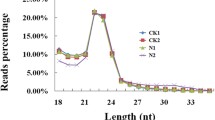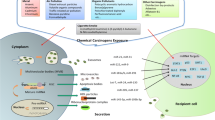Abstract
MicroRNA (miRNA) are approximately 22nt RNA molecules with the ability to regulate gene expression by interacting with its target mRNA. Recent studies demonstrated that miRNA are responsible for determining cell fate and also plays an important role in cellular response to xenobiotics stress and other toxicological phenomenon. Also a number of reports have strengthened the correlation between altered miRNA expression and various cancers. In this study miRNA and mRNA expression profiling was carried out in in-vitro differentiating MCF-7 and HepG2 cell line to understand the effect of nonylphenol (NP), an industrially synthesized environmental toxicant. Analyzing the mRNA-miRNA interaction, we observed correlation between deregulated miRNAs and its predictive differentially expressed target mRNA. We also observed differential expression of two widely studied miRNAs, miR-21 and miR-34 in these cell lines. CTCF is found to be the predictive target of expressed miR-21 in MCF-7. In HepG2 cell line expressed MDM2 is found to be a predictive target of miR-34b. These results support the possible role of miRNA interaction in the expression of its target genes and also ability of environmental toxicant to deregulate miRNA expression.
Similar content being viewed by others
References
Langford, K. H., Scrimshaw, M. D., Brikett, J. W. & Lester, J. N. Degradation of nonylphenolic surfactants in activated sludge batch tests. Water Research 39:870–876 (2005).
Petrovic, M. et al. Occurrence and distribution of nonionic surfactants, their degradation products, and linear alkylbenzene sulfonates in coastal waters and sediments in Spain. Environ Toxicol Chem 21:37–46 (2002).
Soares, A., Guieysse, V., Jefferson, V., Cartmell, V. & Lester, J. N. Nonylphenol in the environment: A critical review on occurrence, fate, toxicity and treatment in wastewaters. Environ Int 34:1033–1049 (2008).
Petrovic, M., Barceló, D., Diaz, A. & Ventura, F. Low nanogram per liter determination of halogenated nonylphenols, nonylphenol carboxylates, and their non-halogenated precursors in water and sludge by liquid chromatography electrospray tandem mass spectrometry. J Am Soc Mass Spectrom 14:516–527 (2003).
Yang, D. K. & Ding, W. H. Determination of alkylphenolic residues in fresh fruits and vegetables by extractive steam distillation and gas chromatography-mass spectrometry. J Chromatogr A 1088:200–204 (2005).
Jorge, E. et al. Migration of nonylphenol from plastic containers to water and a milk surrogate. J Agric Food Chem 52:2016–2020 (2004).
Ambros, V. MicroRNA pathways in flies and worms: growth, death, fat, stress, and timing. Cell 113:673–676 (2003).
Farh, K. K. et al. The widespread impact of mammalian MicroRNAs on mRNA repression and evolution. Science 310:1817–1821 (2005).
Lim, L. P. et al. Microarray analysis shows that some microRNAs downregulate large numbers of target mRNAs. Nature 433:769–773 (2005).
Krutzfeldt, J. et al. Silencing of microRNAs in vivo with ‘antagomirs’. Nature 438:685–699 (2005).
Ramkissoon, S. H. et al. Hematopoietic-specific micro-RNA expression in human cells. Leuk Res 30:643–647 (2006).
Sood, P., Krek, A., Zavolan, M., Macino, G. & Rajewsky, N. Cell-type-specific signatures of microRNAs on target mRNAexpression. Proc Natl Acad Sci USA 103:2746–2751 (2006).
Yamada, J., Kuramochi, Y., Takagi, M., Watanabe, T. & Suga, T. Human brain acyl-CoA hydrolase isoforms encoded by a single gene. Biochem Biophys Res Commun 299:49–56 (2002).
Su, Z. et al. The cancer growth suppressor gene mda-7 selectively induces apoptosis in human breast cancer cells and inhibits tumor growth in nude mice. Proc Nat Acad Sci 95:14400–14405 (1998).
Huang, E. Y. et al. Genomic structure, chromosomal localization and expression profile of a novel melanoma differentiation associated (mda-7) gene with cancer specific growth suppressing and apoptosis inducing properties. Oncogene 20:7051–7063 (2001).
Bionaz, M. & Loor, J. J. ACSL1, AGPAT6, FABP3, LPIN1, and SLC27A6 Are the most abundant isoforms in bovine mammary tissue and their expression is affected by stage of lactation. J Nutr 138:1019–1024 (2008).
Beigneux, A. P. et al. Agpat6-a novel lipid biosynthetic gene required for triacylglycerol production in mammary epithelium. J Lipid Res 47:734–744 (2006).
Zhang, L. et al. Integrative genomic analysis of phosphatidylinositol 3?-kinase family identifies PIK3R3 as a potential therapeutic target in epithelial ovarian cancer. Clin Cancer Res 13(18 Pt 1): 5314–5321 (2007).
Frankel, L. B. et al. Programmed cell death 4 (PDCD4) is an important functional target of the microRNA miR-21 in breast cancer cells. J Biol Chem 283:1026–1033 (2008).
Gramantieri, L. et al. MicroRNA involvement in hepatocellular carcinoma. J Cell Mol Med 12:2189–2204 (2008).
Burke, L. J., Zhang, R., Lutz, M. & Renkawitz, R. The thyroid hormone receptor and the insulator protein CTCF: two different factors with overlapping functions. J Steroid Biochem Mol Biol 83:49–57 (2002).
Recillas-Targa, F. et al. Pigenetic boundaries of tumour suppressor gene promoters: the CTCF connection and its role in carcinogenesis. J Cell Mol Med 10:554–568 (2006).
Urbich, C., Kuehbacher, A. & Dimmeler, S. Role of microRNAs in vascular diseases, inflammation, and angiogenesis. Cardiovasc Res 79:581–588 (2008).
Chen, A. et al. Complementary analysis of microRNA and mRNA expression during phorbol 12-myristate 13-acetate (TPA)-induced differentiation of HL-60 cells. Biotechnol Lett 30:2045–2052 (2008).
Pogribny, I. P. et al. The tumor-promoting activity of 2-acetylaminofluorene is associated with disruption of the p53 signaling pathway and the balance between apoptosis and cell proliferation. Toxicol Appl Pharmacol 235:305–311 (2009).
Li, N. et al. miR-34a inhibits migration and invasion by down-regulation of c-Met expression in human hepatocellular carcinoma cells. Cancer Letters 275:44–53 (2009).
Hermeking, H. p53 enters the microRNA world. Cancer Cell 12:414–418 (2007).
Corney, D. C. et al. MicroRNA-34b and MicroRNA-34c are targets of p53 and cooperate in control of cell proliferation and adhesion-independent growth. Cancer Res 67:8433–8438 (2007).
Toledo, F. & Wahl, G. M. Regulating the p53 pathway in vitro hypotheses, in vivo veritas. Nat Rev Cancer 6: 909–923 (2006).
Vousden, K. H. & Lane, D. P. p53 in health and disease. Nat Rev Mol Cell Biol 8:275–283 (2007).
Okamura, S. et al. p53DINP1, a p53-inducible gene, regulates p53-dependent apoptosis. Mol Cell 8:85–94 (2001).
Oda, K. et al. p53AIP1, a potential mediator of p53-dependent apoptosis, and its regulation by Ser-46-phosphorylated p53. Cell 102:849–862 (2000).
Fazi, F. et al. A minicircuitry comprised of microRNA-223 and transcription factors NFI-A and C/EBPalpha regulates human granulopoiesis. Cell 123:819–831 (2005).
Michishita, E. et al. SIRT6 is a histone H3 lysine 9 deacetylase that modulates telomeric chromatin. Nature 452:492–496 (2008).
Medoff, B. D. et al. CARMA3 mediates lysophosphatidic acid-stimulated cytokine secretion by bronchial epithelial cells. Am J Respir Cell Mol Biol 40:286–294 (2009).
Goodwin, B. et al. A regulatory cascade of the nuclear receptors FXR, SHP-1, and LRH-1 represses bile acid biosynthesis. Mol Cell 6:517–526 (2000).
Salaspuro, M. Acetaldehyde as a common denominator and cumulative carcinogen in digestive tract cancers. Scand J Gastroenterol 24:1–15 (2009).
Guo, R., Zhong, L. & Ren, J. Overexpression of aldehyde dehydrogenase-2 (ALDH2) attenuates chronic alcohol exposure-induced apoptosis, change in Akt and Pim signaling in liver. Clin Exp Pharmacol P 36:463–468 (2009).
Bravo, V., Rosero, S., Ricordi, C. & Pastori, R. L. Instability of miRNA and cDNAs derivatives in RNA preparations. Biochem Biophys Res Commun 353:1052–1055 (2007).
Author information
Authors and Affiliations
Corresponding author
Rights and permissions
About this article
Cite this article
Paul, S., Kim, S.J., Park, HW. et al. Impact of miRNA deregulation on mRNA expression profiles in response to environmental toxicant, nonylphenol. Mol. Cell. Toxicol. 7, 259–269 (2011). https://doi.org/10.1007/s13273-011-0032-y
Received:
Accepted:
Published:
Issue Date:
DOI: https://doi.org/10.1007/s13273-011-0032-y




